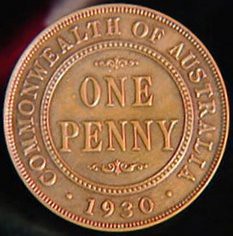
PREV ARTICLE
NEXT ARTICLE
FULL ISSUE
PREV FULL ISSUE
MORE ON THE AUSTRALIAN PROOF 1930 PENNYIn our October 17th issue we published excerpts from an article profiling Australian coin dealer Belinda Downie. Mentioned in the article was a Proof 1930 Penny for sale "from the celebrated collection of A.M. Le Souef, former deputy master of the Melbourne Mint." But the provenance of the coin has been questioned. On the web is a transcript of a July 2009 Australian Broadcasting Corporation program interviewing people familiar with the piece. Here are some excerpts.
KERRY O'BRIEN, PRESENTER: Here is a story about the value of things past. An Australian penny that's known as the king of this country's rare coins, even internationally renowned as the most valuable copper coin of the era, the proof 1930 penny struck purely as a showpiece by the Melbourne mint at the height of the Great Depression has acquired legendary status, both for its exceptional quality and the circumstances of its striking. Just three of the original set of six proof '30 pennies are in private hands, and the one rare coin aficionados consider see as the pick of the bunch has just been offered for private sale. The coin is predicted to fetch as much as $2 million, which would be a world record. But some rare coin experts have questioned the legitimacy of the coin's advertised provenance as the mint master's coin. Tracee Hutchison reports. ROBERT JACKMAN: Being the mint master's coin, so to speak, the one that he chose actually even adds a larger and a better air to it, because that really gives it even more authenticity and attention that people love to have when they're buying rarities. BELINDA DOWNIE: The striking of proof coins was actually at the discretion of the deputy master of the mint. In this particular instance, Le Souef was a passionate collector as well. And the fact that Le Souef chose this one has to be affirmation of the quality of the piece, 'cause he could have chosen any of the other five. TRACEE HUTCHISON: But just how and when that might have occurred is opened to conjecture. According to records in the State Library of Victoria, A.M. Le Souef retired from his position here at the old Melbourne Mint in 1926, four years before the famed '30 penny and proof versions of the coin were struck. Well it's clear Le Souef was a man of great influence during the 1920s, and it was apparently not uncommon for people in his position to be gifted coins, if A.M. Le Souef ever owned a proof 1930 penny, we could find no official record to prove it. The advertised provenance that Le Souef was the coin's first private owner first appeared in the 1980s. It's been accepted as part of the legend ever since. TONY BYRNE, FORMER CHIEF NUMISMATIST, ROYAL AUST. MINT: To me, it's just totally incredible. It's almost as if there had to be some sort of unusual practices if he was to have been back in the mint four years later and getting an unrecorded copy of a proof '30 penny. You know? I didn't believe it initially, I don't believe it now. TRACEE HUTCHISON: Additionally, a comprehensive catalogue of Le Souef's collection compiled in 1986 by the former head of numismatics at Melbourne Museum John Sharples indicates Le Souef stopped collecting in 1928. Two years before the '30 penny was struck. Sharples writes that, "Many coins are wrongly ascribed to him. Over the years, coins ascribed verbally as, 'possibly from the La Souef collection,' have come to be published as, 'from the Le Souef collection'. This is usually in error." TRACEE HUTCHISON: What is undisputed is the coins provenance to the era's most renowned collector, Sydney Hagley, who wrote in 1950, "My first contact with the 1930 penny occurred about 15 years ago when I acquired a specimen from the Adelaide Gallery duplicates; this was a proof." TONY BYRNE: In speaking to Hagley, he said the coin had been donated to him by the South Australian gallery in response to his assistance, donations, etc. over the years. So then I couldn't see how Le Souef became involved. WALTER BLOOM: I can't see that that makes a great difference to the asking price. I mean, this is a rare coin, it is a beautiful coin, and it is very desirable. And that's what's important for a modern coin like the 1930 penny. TONY BYRNE: To me, the coin stands alone. It's a proof, it's a 1930, it's a magnificent item. It doesn't need prominent people provenance.
To read the earlier E-Sylum article, see:
ARTICLE PROFILES COIN DEALER BELINDA DOWNIE
(www.coinbooks.org/esylum_v13n42a15.html)
The Numismatic Bibliomania Society is a non-profit organization promoting numismatic literature. See our web site at coinbooks.org. To submit items for publication in The E-Sylum, write to the Editor at this address: whomren@gmail.com To subscribe go to: https://my.binhost.com/lists/listinfo/esylum All Rights Reserved. NBS Home Page Contact the NBS webmaster 
|
